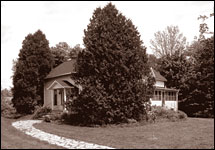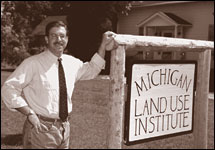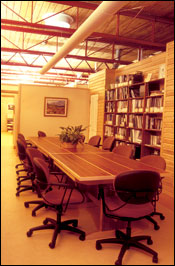MLUI / Articles from 1995 to 2012 / The Institute Ten Years On
The Institute Ten Years On
Useful tussles, starting something good, and new paths to prosperity
November 14, 2005 | By Keith Schneider
Great Lakes Bulletin News Service
 | |
| MLUI/Pat Owen | |
The Institute’s first home, in Benzonia. |
My colleague Patty Cantrell, who’s attracting a lot of deserved attention for making it easier for Michigan farmers to sell their food to people like you and me, was profiled last month in Traverse Magazine. Jeff Smith wrote about Patty’s Missouri farm roots, her intellect, and her motivations as an advocate, journalist, and former Fulbright scholar with an MBA.
“So much of environmentalism has to do with stopping something bad,” Patty told Jeff. “I wanted to be involved with starting something good.”
The Michigan Land Use Institute is ten years old now. In ways big and small, Patty’s vision, along with her ability to steadily achieve it, are emblematic of her growth as a community leader—and our evolution as a public interest organization.
It’s been some years since the Institute’s primary projects were about getting in the way of the dons of bad development—the energy boys, highway builders, property rights ideologues, and the rest of the growth-at-any-cost crowd. It’s not that we now shy away from useful tussles. It’s just that, these days, Patty’s view about making good things happen is more to the point.
We’re convinced that Michigan is more ready than ever to conserve farmland and improve the profitability of farmers—Patty’s focus. In Detroit we’re working with a coalition focused on reviving neighborhoods. Our water project, led by Andy Guy, aims to protect the state’s fresh water not only through innovative new standards, but also by showing that preserving it boosts Michigan’s economy. And, in northwest Lower Michigan, the Institute is launching a five-year plan devoted to securing the region’s natural geography and small-town character—and increasing its economic prosperity.
In short, we are promoting a new economic strategy that turns aside our spread out and wasteful patterns of growth and builds more environmentally sensitive, energy-efficient, fiscally responsible, culturally engaging communities.
Changing Times
 | |
| MLUI | |
| Sign of success: Co-founder Keith Schneider in 1995. |
We feel needed. A gale of population growth and new construction is battering northern Michigan, abusing the landscape with elements of 20th-century development that few want anymore: Cherry orchards buried under parking lots. Leafy country lanes straightened, widened, traffic-choked. The whippoorwill’s dusky song wiped away by big-box, fast food, convenience store sprawl.
Geography and history are colliding across other parts of the state, too. The conditions that drained Michigan’s big cities and pumped up suburban sprawl—cheap energy and land, rising incomes, massive government spending for roads and water systems—are disappearing. We believe those tectonic trends are permanent, not temporary.
For most of the 20th century, almost every aspect of the American way was tied to roads and cars. But what if roads and cars are becoming symbols of America’s vulnerability? What if our cracked highways, slow population growth, high unemployment, industrial bankruptcies, and static home prices are not temporary troubles but are, like dogs barking before a storm, alerting us to an economic maelstrom that could permanently damage Michigan? What if our endlessly mobile, sprawling lifestyle is turning out to be a mad dash to economic decline?
Exciting News
 | |
| MLUI | |
| The Institute’s Web site, promotional materials, and publications spread the Smart Growth message. |
communities.
Grand Rapids, for instance, is changing from a decaying industrial city into a modern biomedical, recreational, and higher-education metropolis by investing in public transit, housing, schools, and jobs in neighborhoods and business districts. Ann Arbor established a greenbelt to conserve farmland and is planning to significantly increase the number of people who can afford to live downtown.
The national news is even more exciting. Salt Lake City is building efficient public transit lines and beautiful neighborhoods next to attractive business districts and civic spaces. Of the one million people expected to move there over the next 20 years, almost all will live and work within a short walk of public transit. The plan conserves 80,000 acres of farmland and saves taxpayers more than $15 billion in infrastructure costs over the next two decades.
Denver’s Smart Growth strategy includes a $5 billion, 130-mile regional system of rapid bus and train lines. Portland, Ore., rebuilt its regional economy around new nodes of business and housing that sprouted around public transit stations.
These and other places, anticipating looming transformations in the economy, the environment, and demographics, are changing market signals and government investment patterns to encourage new, more competitive designs for growth.
The Next Ten Years
 | |
| MLUI/Heidi Johnson | |
| Our home office, in Beulah, uses recycled materials, including the redwood in its conference table. |
Our new, five-year plan for the Institute’s home territory, northwest Lower Michigan (see box), is the model for similarly detailed plans for other parts of the state. Wherever we work, we’ll demonstrate the huge market for land conserving, walkable neighborhoods and traditional town centers. And, because the best way to encourage Smart Growth is to make it much easier for developers to build great places, we’ll convince local officials and Lansing to enact much-needed new policies. The state must provide local governments with the guidance, money, and incentive needed to facilitate Smart Growth.
In 1998, when Patty joined us, we knew that it was possible and practical for development to improve, rather than degrade, our communities. We spent a decade spreading that concept to thousands of people, even as we fought tough battles to stop some very bad developments. Along the way, we noticed that just about the only civil conversations liberals and conservatives, farmers and environmentalists, blacks and whites, rich and poor have are about how their communities should grow. And, regardless of political affiliations, the solutions these different folks come up with look surprisingly similar.
Good examples abound. Voters in 13 of 14 Michigan communities—many of them rural and conservative—approved property tax increases last year to strengthen their local bus systems. A half-dozen suburban Michigan communities have recently held referendums to block big-box superstores. Voters in conservative Ada Township, outside Grand Rapids, voted to curb sprawl by doing the same thing that voters in liberal Ann Arbor did: Approve property tax increases that pay for conserving open space and farmland.
Once we were a staff of three, with little experience, some naiveté, and tons of chutzpah. Now there are 17 of us, in five offices stretching from Harbor Springs to Lansing. The Institute team, several of whom, like Patty, are nationally regarded, is wiser now. We’ve made a lot of deep, lasting friendships and powerful alliances. We earn our support from a renowned board, 2,500 members, and a growing assembly of donors and foundations.
Our first decade was a time of testing techniques, developing coalitions, achieving grassroots successes, and building an influential organization. In our next we will establish a new development strategy and convince our leaders to embrace it. The Institute will stay at the center of Michigan’s Smart Growth movement, improving the well-being of our state, our families, and the places we call home.
Keith Schneider is the Institute’s deputy director. Reach him at keith@mlui.org.





